The post The power of dedicated thanks & gratitude appeared first on Socialbrite.
]]>
Students play at the original site of Shepherds Junior School in Arusha, Tanzania.
How your nonprofit can promote followership and build deeper relationships
Target audience: Nonprofits, NGOs, foundations, cause organizations, businesses, brands, individuals, social media consultants, individuals.
I don’t think I’ve ever worked with an organization quite like Epic Change. Founder Stacey Monk believes that “intention makes a powerful difference.” Epic Change is really all about intention: intention to build, fund, and support a school that literally changes the lives of children. Intention to listen. Intention to include everyone who wants to be part of the organization, and let everyone own this thing called Epic Change.
Epic Change is an example of an organization that really gets the idea of following its members, and intentional listening. Allison Fine recently wrote about this concept of “followership.” The bottom line, as Allison puts it, is to “follow or become irrelevant.” If your organization isn’t willing to listen and include its followers, then it may well become irrelevant. As we’ve written before, Epic Change is anything but. Stacey and co-director Sanjay Patel invite anyone who is “heartfully connected” (Stacey’s words) to become part of every online campaign, from planning through execution. They have three signature events: To Mama With Love, LalaLove, and now, Epic Thanks. Followers’ ideas are listened to seriously and included in the final product. In turn, Sanjay and Stacey also bounce their ideas off of the group and ask for feedback, always listening and always respectfully incorporating ideas. What has become Epic Thanks is truly a result of great followership.
One example of followership is the gratitude dance idea. Sanjay Patel posted a video of the dance within the Epic Thanks planning group. Within minutes, the conversation within the planning group evolved from “I’m so not dancing” (me) to “what if we had a dance-off?” (Stacey) to” let’s make a thank-you dance video if we hit our target amount!” And, of course, Stacey replies, “Let me see what we could build to host the video…may be able to get something up tomorrow.” Later that day, Stacey writes that she’s already filmed Leah, Gideo, and Mama Lucy (from the school) dancing and ready for their final thank-you dance video.
‘Tis the season to embody followership
I cannot think of a better example of followership than Epic Change. This Thanksgiving season, as in years past, Epic Change is raising money to support the Shepherds School in Arusha, Tanzania. The past three years, Epic Change has supported the school through a worldwide gratitude event called Tweetsgiving. It raised thousands of dollars to build and support the Shepherds Junior School, a primary school. Now the kids who had nowhere to go for an education are hoping that their dreams of becoming lawyers, doctors and astronauts will continue with a secondary school education. The kids who started in fifth grade three years ago are ready for secondary school, but there is no secondary school in Arusha that will nurture and support these dreams. I met two of these students, Leah and Gideon, when they came to Boston two weeks ago with Mama Lucy. If I do nothing else, I want them to have a chance to make their dreams come true.
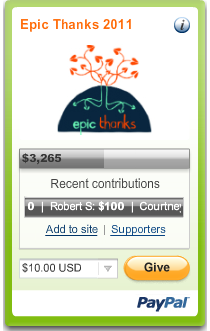
So here’s my promise: I’ll dance if I reach my fundrasing goal of $100 for Epic Thanks. Please consider donating any amount, even $1, to a worthwhile cause. And to an organization that supports followership, intention and children’s dreams.
I’m a terrible dancer, so this could get interesting. (But not as bad as Matt, apparently.)
Photo at top by Stacey Monk, Epic Change, 2007
 This work is licensed under a Creative Commons Attribution-NonCommercial 3.0 Unported.
This work is licensed under a Creative Commons Attribution-NonCommercial 3.0 Unported.
The post The power of dedicated thanks & gratitude appeared first on Socialbrite.
]]>The post Lessons learned from the To Mama With Love campaign appeared first on Socialbrite.
]]>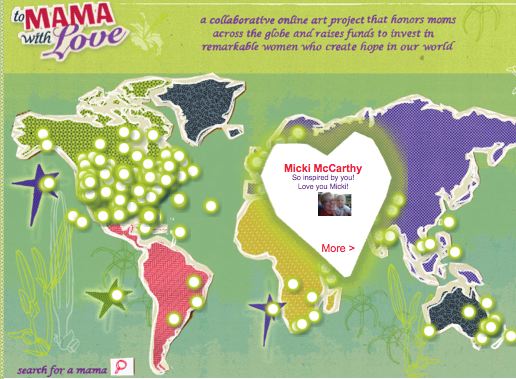
JustCoz, Twibbon, Google Docs were among tools used for community engagement
Guest post by Amy Sample Ward
Membership Director, NTEN
 Every campaign, every organization, every individual engaging with others online has a set of tools and techniques they’ve learned from and rely on every day. Building community and maintaining engagement is often a full-time job – even if it goes unpaid.
Every campaign, every organization, every individual engaging with others online has a set of tools and techniques they’ve learned from and rely on every day. Building community and maintaining engagement is often a full-time job – even if it goes unpaid.
Epic Change is no different. The To Mama With Love campaign saw them try some new tools as well as some trusted favorites, even with no budget and lots of volunteer time.
Twitter is a major part of Epic Change campaigns and their daily engagement plan. To Mama With Love is no exception – but, as Stacey Monk, CEO of Epic Change, reflects, “It’s a much different medium than it used to be.”
Two or three years ago, you could have a conversation out in the open and have people organically join in. It’s much more challenging to do something like that now. The 2011 To Mama With Love activity on Twitter was driven primarily by people very close to the campaign, whereas the first Tweetsgiving was driven by people Stacey didn’t know yet or hadn’t invested time cultivating relationships with.
More than 180 people with over 635,000 total followers signed up to participate by authorizing Epic Change to post via their Twitter account using JustCoz, an online relay system that lets you donate a tweet a day to help raise awareness for causes that matter to you.
While there were a few instances of serendipity – where notable JustCoz participants like prominent technologist & entrepreneur Jeff Pulver (who has over 400,000 followers) were retweeted by followers like Cisco CTO Padmasree Warrior (who has nearly 1.4 million followers) – Stacey points to the difficulty in getting people to join in the conversation on Twitter.
Some messages sent by Epic Change via their 180+ JustCoz participants would get zero response — from over 635,000 total followers. “No one seems to be listening anymore,” Stacey said.
 By comparison, when Epic Change launched the original TweetsGiving in 2008 – when Stacey herself had far fewer followers & the Twitter ecosystem itself was exponentially smaller – the campaign generated over 3,000 tweets in just 48 hours.
By comparison, when Epic Change launched the original TweetsGiving in 2008 – when Stacey herself had far fewer followers & the Twitter ecosystem itself was exponentially smaller – the campaign generated over 3,000 tweets in just 48 hours.
Twitter should be used for cultivation, not broadcasting. Stacey uses it for one-to-one personal connections. She explains that when they first approached Twitter, they thought it would be a way to amplify voices of people who weren’t being heard. Now it seems like no one will be heard.
JustCoz: Relying on focused engagement
Twitter was thought of separately than JustCoz for just this reason. Focused engagement, with direct messages, replies and retweets, required a different process and purpose than broadcast messages.
The limitations of JustCoz include the ability to send messages only once every 24 hours (meaning, at least 24 hours must pass between messages), messages go out through all authorized accounts at once (there’s no option to stagger posts) and you have only one message (there is no segmenting).
In Stacey’s opinion, the most helpful tweets are the ones written authentically from the first person. You can’t do that when you’re mass-tweeting.
Stacey and her team thought JustCoz could be a good way to get people involved and start generating buzz before the site actually went live, and then maintain some messaging throughout the campaign.
How did it go? Well, like much of social media, it depends on the message. Here are a few of the examples:
- When we asked people to join by tweeting, because it was easy and different, we went from 20 to 180 people who had signed up to let us tweet through their accounts.
- When we tweeted with the ask “write a love note,” we generated more responses to that during the campaign than actual campaign messages.
- We thought we could generate a conversation but it didn’t happen. That may have been because the “tweeter” of the message wasn’t aware that they’d tweeted anything, so couldn’t carry on the conversation. Stacey offered that it would be helpful if JustCoz participants received a direct message any time a message was sent from their account.
Twibbon, Pitch Engine and blogger outreach
Epic Change also incorporated Twibbon into the To Mama With Love campaign. Supporters simply connected their Twitter profile with Twibbon on the TMWL Twibbon page, and the tool updated the Twitter profile picture of the user with an overlay that included the campaign logo and hashtag. According to the Twibbon profile for TMWL, 667 users added the badge to their pictures.
In addition to Twitter, two volunteers created separate press releases about the campaign on PitchEngine to spread through their networks. Stacey does feel that it’s a useful and simple tool that can help spread your story, but had there not been volunteers in the public relations industry involved in the group, she may not have made the time to use the platform.
When it came to blogger outreach, a Google Doc was the preferred and successful tool. They were able to update it at any time with all the information necessary to reach out to, orient and support bloggers spreading the message about the campaign.
The first TMWL campaign used a highly customized WordPress site. To incorporate the level of functionality and customization they wanted for the 2011 campaign, Epic Change recruited a volunteer developer to redesign the site in PHP.
They did not have a preference in mind for the redesign when it came to the programming language, just a clear understanding of what they wanted supporters to be able to do. That directed the build. PHP was selected because that’s what the developer volunteering to contribute the tremendous amount of work and hours was most comfortable with.
The team had about six to eight weeks of development from mock-ups to live site. But, again, that was with incredibly capable developers passionate about the work and campaign. In most cases, it should be noted, the process would take longer. An important contributing factor to the speed at which they could build the site was their clarity around what they wanted and needed; they never changed their minds or redesigned aspects during the process.
Bit.ly was another major infrastructure component, Bit.ly is a URL shortener that allows you to track your links across social media as well as customize the shortened link. Epic Change had an organizational account and almost always gave a URL they were using in email, Facebook or Twitter a unique URL that matched the content or ask. Especially when it was a URL to pages they would reference often, like the sign-up pages to join the volunteer team, creating the shortened URLs helped them share easily while making it easy for supporters to share appropriate links, too.
The third part of the TMWL infrastructure was Radian6, a social media monitoring service. Radian6, which was acquired by Salesforce on March 30, sponsored the campaign by providing Epic Change with free access to the monitoring tool. This allowed Stacey and the team to have real-time access to detailed metrics, making it possible to revise the messages & tactics on the fly.
Manymoon: Project management app connects to your Google accounts
Planning tools abound, especially for small teams looking to use a Web-based tool to keep everyone connected and informed at any time, from anywhere. Epic Change used four planning tools, but much of the work was really in just two: a private Facebook group and Google Docs.
With the intention of using a project management tool to be organized and purposeful before the campaign, and during, Stacey set up the team with Manymoon, a project management application that connects to your Google apps/Gmail accounts. Stacey felt it was a great tool, but they didn’t use it effectively. Furthermore, asking volunteers to master a tool that’s not entirely intuitive — that’s the biggest fault with most every project management tool on the market — is a stretch. Ultimately, Manymoon was helpful for putting the plan together between Stacey and Sanjay. They will look for another tool to use next time specifically for site development planning.
Stacey found that what they were trying to do in a project management space wasn’t really project planning, but organizing the volunteers and volunteer opportunities. As such, creating Google Docs let them have varying levels of privacy for different documents – some were intended to be shared publicly, others with just the team and so on – as well as update content easily and in real time. Some of what they used Google Docs for included:
- A new form for supporters to sign up for various missions
- Information for bloggers
- Information about the campaign and how to get involved
To make the Google Docs even easier to share, Stacey created custom URLs for the pages using Bit.ly.
The bulk of the communicating, organizing and planning – both before the campaign launched and during – was carried out through the private Facebook group. Stacey was already participating in private groups to have an idea of the functionality and options and found private groups could be really engaged – especially because of the functionality and layers of notification settings that Facebook provides across the platform.
One aspect they were dissatisfied with about the Google Group from the 2010 campaign was the broadcast feeling of the emails, often resulting in Stacey being the only one to start a conversation or share a message. On the flip side, they found the Facebook group allowed for people to start their own threads and conversations. This wasn’t because of any difference in permissions between the two platforms but because discussions in Facebook’s groups are all visible and non-linear, whereas email can often lead to conversations getting muddled or people reading and following without responding.
Using both Facebook and Google for groups
Stacey struggled with the decision to commit so much time, energy and focus on Facebook during this campaign because of the ethical questions around the site’s practices regarding personal privacy, data sharing and so on. They had a lot of conversations around whether they wanted to be in there; they knew there were people who would have participated but do not want to be on Facebook. It was a difficult decision that meant people would be left out.
Despite the downside, they do want to nurture the group that formed there in between campaigns and get people involved further ahead of time for the next campaign. Ideally, though, Stacey says she’d like to see something that is equally useful and easy to use, but that will allow everyone in. She’d like to have the option of choosing both utility and ethics.
Since the Facebook group kept most of the supporters and volunteers engaged throughout the day with updates, idea sharing and feedback, the Google Group was used mostly for major updates to ensure that important announcements made it through to everyone involved. Since Facebook’s notification settings can be set to receive no email updates from groups, Stacey felt it was important to send periodic updates through the Google Group as a supplement, even though it was not very good for conversation. She thinks they may move to MailChimp next year.
Because it is a fundraising (and love-sharing) campaign, it could be argued all of the tools are fundraising tools. But, as for specific technologies used for transactions, there were just two: bitcoin and PayPal.
Representatives from bitcoin, a peer-to-peer currency exchange, reached out to Stacey before the campaign. Epic Change decided it could be an interesting way to allow for donations, so they added it to the TMWL site. Ultimately, only one person used it. Since it does not require extra work or management by Epic Change, they may continue to offer it for their campaigns and measure any growth in interest.
PayPal was the the workhorse, as it managed all of the donation processing. PayPal offers reduced fees for 501(c)3 organizations and is a flexible tool for donors (not requiring a PayPal account, for example).
Have you used any of these tools? Please share your questions and your experiences!
Related
• Plant the seeds of hope wherever you can (Socialbrite)
• 5 lessons from a crowdsourced birthday party (Socialbrite)
• Why you need to share your story (Socialbrite)
 This work is licensed under a Creative Commons Attribution-NonCommercial 3.0 Unported.
This work is licensed under a Creative Commons Attribution-NonCommercial 3.0 Unported.
The post Lessons learned from the To Mama With Love campaign appeared first on Socialbrite.
]]>The post Four types of social media strategies for nonprofits appeared first on Socialbrite.
]]>
 Most nonprofits that jump into social media have one goal: To see how hot or cold the water is.
Most nonprofits that jump into social media have one goal: To see how hot or cold the water is.
Only when they’ve gotten their feet wet do they scratch their heads wondering: “Why are we in this pool anyway?”
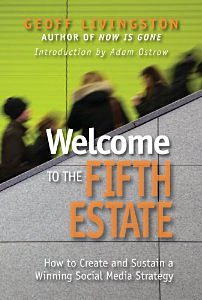 Geoff Livingston (1/4 of Zoetica Media) shared a chapter from his book “The Fifth Estate” — due out next week — about four different types of social media strategies:
Geoff Livingston (1/4 of Zoetica Media) shared a chapter from his book “The Fifth Estate” — due out next week — about four different types of social media strategies:
- Participating with People – This strategy focuses on creating real dialogue with your stakeholders. Think Zappos (pictured at top).
- Serving with Content – This strategy focuses on using valuable and interesting content to attract and retain fans.
- Engage Influencers – This strategy focuses on leveraging real connections you might have with “influencers” (air quotes). You too should put air quotes around “influencers” because one’s influence isn’t half as valuable as their interest.
- Empowerment – This strategy focuses on empowering your fans to create and share their own content. One of the best examples of nonprofits that do this is Epic Change.
Of course, all these strategies can be used in combination. And, of course, you would start with your goals.
You can pre-order Geoff’s book here.
 This work is licensed under a Creative Commons Attribution-NonCommercial 3.0 Unported.
This work is licensed under a Creative Commons Attribution-NonCommercial 3.0 Unported.
The post Four types of social media strategies for nonprofits appeared first on Socialbrite.
]]>The post How to create love online: To Mama with Love appeared first on Socialbrite.
]]>Honor your mom by supporting schools & women’s shelters abroad
With Mother’s Day just around the corner, let’s give props to To Mama With Love, a collaborative online art project that honors moms across the globe and raises funds to invest in remarkable women who are transforming our world. An initiative of Epic Change, the folks behind Tweetsgiving, To Mama With Love is simply about creating and spreading love.
In the grassroots effort, which runs through Sunday — Mother’s Day — participants create socially shareable “heartspaces” that include words, videos, photos and investments in honor of mamas they love. The change-makers are four incredible women who have created schools and shelters for children who face poverty, illiteracy, and lack of opportunity in Nepal, Afghanistan, and Tanzania. Epic Change’s goal this year is to raise at least $65,000 to invest in Mama Lucy’s secondary school in Tanzania; Renu and Maggie’s schools in Kathmandu & Surkhet, Nepal, and Suraya’s women’s shelter in Afghanistan.
To Mama With Love is a social media fundraising campaign, and it has been designed carefully for success. Epic Change has taken every principle of great community organizing and integrated it into To Mama With Love. If you want to run a successful social media fundraising campaign, you can’t do better than to follow their lead. Here’s how:
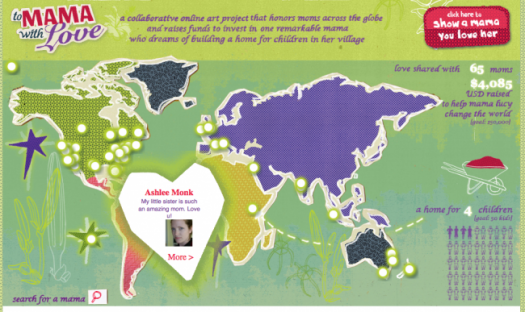
6 tips for running a successful social media campaign
1. Cultivate a community of stakeholders. Stacey Monk, Epic Change’s founder, is a gardener. She has spent years planting seeds of love and cultivating a community of giving. She cultivates the “magic middle” of stakeholders, activists, and influencers who would genuinely care about a cause such as Epic Change’s.
2. Nurture leaders. This year, Epic Change created a private Facebook Group to discuss the campaign before launch. Stacey invited people into the group that she’s been cultivating for years (and who have shown interest in Epic Change). Then she nurtured them.
- She asked people to introduce themselves within the group.
- She asked for volunteers to help with tasks (proofing the press release, developing a Twitter list, inputting a database list, etc.).
- She asked people to invite their friends into the group, and welcomed those friends as they joined.
- Stacey created questions within the private group to bring out our expertise: a win-win for all.
3. Create campaigns with your stakeholders. Stacey consistently asked the group for help refining the campaign. She asked questions such as whether we send the blogger invitations during the weekend or not, should she redesign the home page in a certain way, and when should people tweet? She listened and followed the group’s consensus.
4. Be transparent and inclusive. Campaign documents are posted for all to view and comment upon. Questions are encouraged, and comments are invited.
5. Design commitment. Before joining the group (or upon joining), we were asked to commit to at least one “mission,” which we committed to through a form. Missions included: Invite five others to join the group, commit to writing a blog post, commit to donating money during the campaign, create a heartspace, send emails, and “nudge an influencer.” Stacey sends out mission reminders and asked us to post which missions we completed to the private Facebook Group.
6. Recognize those who are giving. The To Mama With Love website recognizes the bloggers, donors, and the volunteers who helped to plan the event very publicly. This is the very the community that Epic Change has spent the time cultivating.
One other thing: When I volunteered to help out with Epic Change’s Tweetsgiving 2010 campaign, Stacey Monk personally called me at home to thank me the night before the launch. In doing so, she instantly created a more personal, stronger offline connection out of our online connection, strengthening the connection.
Stacey has created a family you want to be part of, one that supports each other and offers collaboration and encouragement … en route to changing the world.
This is a cause I believe in tremendously, and it aligns with my vision of creating a just world of opportunity. My mother was one of the 1970s-era equal rights activists who marched, protested, fought for an equal rights constitutional amendment, attended a world conference on women, and put her money where her mouth was to fund Emily’s List. I’m honoring my mother, Susan Silverman Askanase, in my heartspace.
To create your own heartspace and honor a mama you love, go to http://www.tomamawithlove.org
 This work is licensed under a Creative Commons Attribution-NonCommercial 3.0 Unported.
This work is licensed under a Creative Commons Attribution-NonCommercial 3.0 Unported.
The post How to create love online: To Mama with Love appeared first on Socialbrite.
]]>The post How to make Twitter campaigns more effective appeared first on Socialbrite.
]]>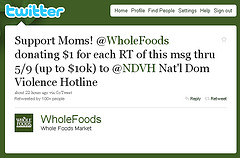
The secret: Moving up the Ladder of Engagement
 Whole Foods is among those sponsoring a Mother’s Day fundraising campaign on Twitter. Whole Foods is donating a $1 for each retweet of this tweet to support The National Domestic Violence Hotline. I call this type of fundraising campaign the sponsored Tweet approach, where potential donors do not have to open their own checkbooks but instead retweet or use a hashtag to leverage a donation from a corporate sponsor to a charity. One of the earlier examples of this was the HoneyBees Campaign on Twitter sponsored by Haagen-Daaz Ice Cream. (See Juilos Vasconcellos’ analysis.)
Whole Foods is among those sponsoring a Mother’s Day fundraising campaign on Twitter. Whole Foods is donating a $1 for each retweet of this tweet to support The National Domestic Violence Hotline. I call this type of fundraising campaign the sponsored Tweet approach, where potential donors do not have to open their own checkbooks but instead retweet or use a hashtag to leverage a donation from a corporate sponsor to a charity. One of the earlier examples of this was the HoneyBees Campaign on Twitter sponsored by Haagen-Daaz Ice Cream. (See Juilos Vasconcellos’ analysis.)
With all fundraising and activist campaigns, I think it is important to think of your conversation and messaging strategies in the context of the Ladder of Engagement – whether you are focusing on one campaign or your fundraising campaigns for the whole year.
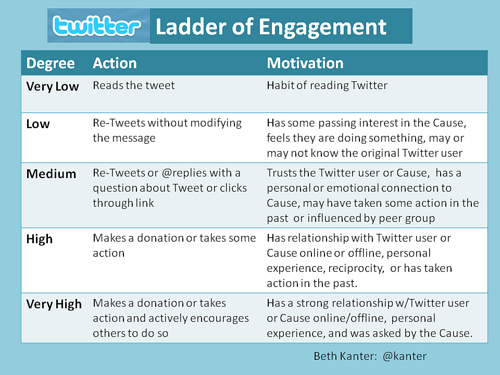
Think about all the various ways your organization interacts with different groups of people through its communications and fundraising efforts – through social media or other traditional channels. You will no doubt discover that some people engage with you lightly and others will engage with you more deeply. Face it, not every single person your organization touches will have the same level of passion or interest in your program. And, that is not a problem, it’s just the way it is.
To be successful in integrating social media into your fundraising channels, you need to use different techniques, tactics and tools to map to the person’s level of interest. You need a portfolio of approaches or maybe even campaigns that meet people where they are at and help get them more engaged with your cause and organization.
Single Call To Action: Spread Awareness
The Whole Foods sponsored retweet donations is focused on a lower level of engagement, simply spreading the message. This type of campaign is a win-win for sponsors and for nonprofits that need to boost awareness of their issue and have just started dipping toes into the social media waters.
What is missing is some mechanism for the nonprofit to reconnect with those who are retweeting the message and engage and educate them, perhaps getting them to the point of making a donation, volunteering or signing up for a newsletter.
Integrated Call To Action: Spread Awareness and Donate
My colleague, Geoff Livingston, recently wrote an analysis on Mashable about Twitter’s new social good initiative Hope 140. The first effort was the #EndMalaria campaign that used the TwitPay platform for donations, creating a combined call to action that asked Twitter users to retweet by donating $10. The Case Foundation matched donations with a $25,000 grant. The effort raised over $11,000.
Ecosystem of Calls To Action: Spread Awareness, Donate, and Create Content
Another example of this combined called to action comes from Epic Change and its “To Mama With Love.” Their call to action focuses on donating and user-generated content. What I think has made this campaign catch on is that it is powered by love or an emotion we feel for our mothers or being a mother. Also, Tweetsgiving has been building and cultivating a network and has now has a cadre of people who are engaging in a deep way by encouraging peers to participate.
Conclusion
It is important to understand that these levels of engagement are part of an ecosystem. While fewer people may reach the very highest levels of engagement because of the time commitment, personal connection or interest, those with lower engagement are important to the ecosystem because they spread awareness. Recognize and appreciate people where they’re at, and work to get more people engaged as you strive to gently nudge them further up the rungs of your ladder.
This takes a combination of tactics and approaches – from one-on-one relationship building to more broadly spreading your message. You need also take into account where you are in developing your network at all times. You should be nurturing those higher levels of engagement outside of campaign mode. You also need metrics and measurement to see what works in terms of moving people up the rungs!
What is your repertoire of engagement techniques to inspire people to move up the ladder? Are you thinking about it one campaign at a time or as an ongoing activity that includes campaigns? How do you balance your social media strategy so it includes both low and high levels of engagement?
Cross-posted from Beth’s Blog.
 This work is licensed under a Creative Commons Attribution 3.0 Unported.
This work is licensed under a Creative Commons Attribution 3.0 Unported.
The post How to make Twitter campaigns more effective appeared first on Socialbrite.
]]>The post TweetsGiving: Ways to show your gratitude appeared first on Socialbrite.
]]>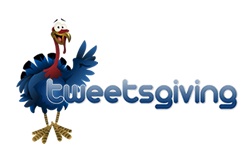 There are just six days to go before TweetsGiving! Next week, participants will share what they are grateful for through Twitter and other online media and attend gratitude parties around the world.
There are just six days to go before TweetsGiving! Next week, participants will share what they are grateful for through Twitter and other online media and attend gratitude parties around the world.
People will donate to a shared cause in honor of that for which they are most grateful. Funds raised will go to support the work of Mama Lucy Kampton (@MamaLucy), a change maker who has transformed her community in Arusha, Tanzania, through her school, Shepherd’s Junior.
Learn more and show your gratitude!
Scheduled for Nov. 24–26 (Tuesday to Thursday), the 48-hour event created by Epic Change will encourage participants to express their thanks using online tools and at live events. In honor of the people and things that make them grateful, guests will be invited to give to a common cause at events held across the globe.
Why TweetsGiving?
Last year, funds from TweetsGiving helped build a classroom in Tanzania. This year, the Epic Change team is working on building a technology lab there.
Earlier this month, we interviewed Avi Kaplan from Epic Change and asked him what they were planning in Africa.
What are you up to right now in Africa?
We just spent three weeks at Shepherd’s Junior near Arusha, Tanzania setting up a technology lab and wireless internet at the school. Together with our fabulous volunteers Melissa & AJ Leon of theLacProject, we taught the students and teachers about computers and social media. The students of Class Five at the school are now on Twitter and Tumblr and you can follow them all by clicking their pictures in this blog post. The internet has opened up the world for these students and their teachers are increasingly using the web in their curriculum.
For more details from our recent work here, including video, photos and more in-depth coverage of all about the work we’ve been up to in Tanzania on the “I <3 Epic Change” Blog created by theLacProject and in a recent article in the Huffington Post.
Get involved
Here’s how to get involved:
- Attend a gratitude party
- Spread gratitude on the web
- Host a gratitude party
- Join the TweetsGiving Community
Look for more information about TweetsGiving next week on Socialbrite.
 This work is licensed under a Creative Commons Attribution-NonCommercial-ShareAlike 3.0 Unported.
This work is licensed under a Creative Commons Attribution-NonCommercial-ShareAlike 3.0 Unported.
The post TweetsGiving: Ways to show your gratitude appeared first on Socialbrite.
]]>The post Why you need to share your story appeared first on Socialbrite.
]]>
 The sprouted seeds that create most non-profits are often powerful and personal stories. Stories that can revive a bored board meeting or fuel a fundraising event. They can be told with pictures, videos, or blog posts.
The sprouted seeds that create most non-profits are often powerful and personal stories. Stories that can revive a bored board meeting or fuel a fundraising event. They can be told with pictures, videos, or blog posts.
But sometimes they need to be told face to face.
Last weekend I had the privilege of attending a meet-up in Florida with Patience Salgado, Sanjay Patel, Liz Rosas, Shannon Aronin, Danny Brown, Stacey Monk, Jen Lemen, Vince Hunt, Charles McKeever, Avi Kaplan, Kira Siddall. Without getting into the details, the main point of this meeting was to deepen our connections with each other. We did this by sharing our stories and dreams.
 I interviewed Stacey Monk a few months ago, so I was familiar with the Epic Change mission and their success with Tweetsgiving. But I wanted to hear the personal backstory. I wanted to hear the “why.”
I interviewed Stacey Monk a few months ago, so I was familiar with the Epic Change mission and their success with Tweetsgiving. But I wanted to hear the personal backstory. I wanted to hear the “why.”
So when I had a minute alone with her, I asked: “Why did you start Epic Change?”
What followed was an exchange that helped me renew my own personal dreams and resolutions — my “whys.”
Six and a half years ago, Stacey’s brother died from a drug overdose, devastating his family and leaving behind his 4-year old daughter, Zoe. The morning of his death, Stacey went through photographs in her mind, including one of a double rainbow she snapped while flying over the Rocky Mountains.
Stacey remembered thinking how sad it was that her brother never had a chance to see such beauty. Five years after his death, she reflected: “I think I travel so much now because I want to take him to all those amazing places that he missed. People often ask me why I went to Africa. I think I went to take Josh.”

Stacey realized that life is short, but the value left after one’s death is forever. A couple of year later, Epic Change was born.
I shared with Stacey my story as well, which I’ve shared throughout my blog. And in my heart, I renewed my resolution on behalf of my Mom.
Do you think Epic Change has new meaning for me?
I used to think Epic Change was about making lasting, positive change in the world. But now I know that it’s much more than that. Epic Change is really about the change Stacey made in her life — an individual human revolution as a result of tragedy. It’s about the epic changes I’ve made and will continue to make in my life. It’s about the epic change in your life too.
One more question: Do you think I’m more committed than ever to see Epic Change succeed?
That’s why we need to share our story.
 This work is licensed under a Creative Commons Attribution-ShareAlike 3.0 Unported.
This work is licensed under a Creative Commons Attribution-ShareAlike 3.0 Unported.
The post Why you need to share your story appeared first on Socialbrite.
]]>

